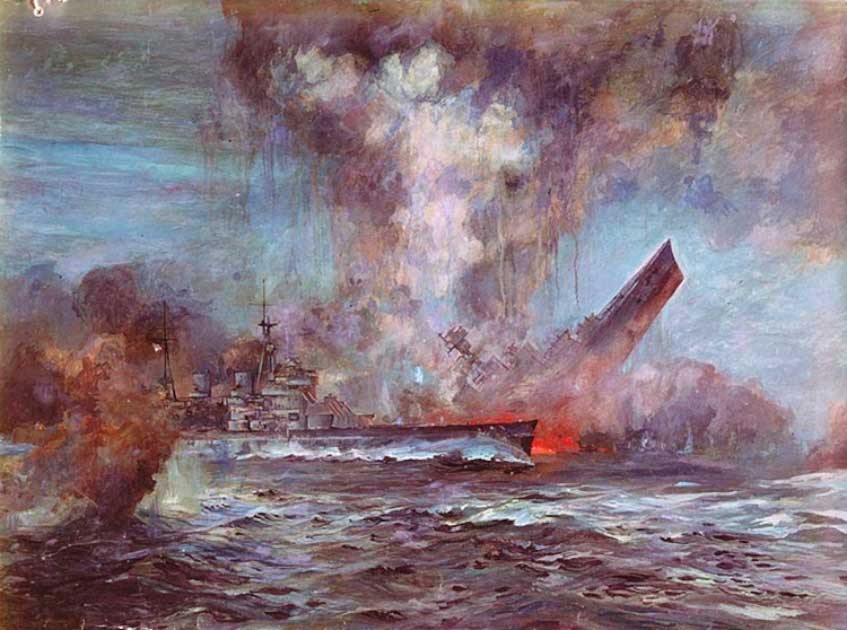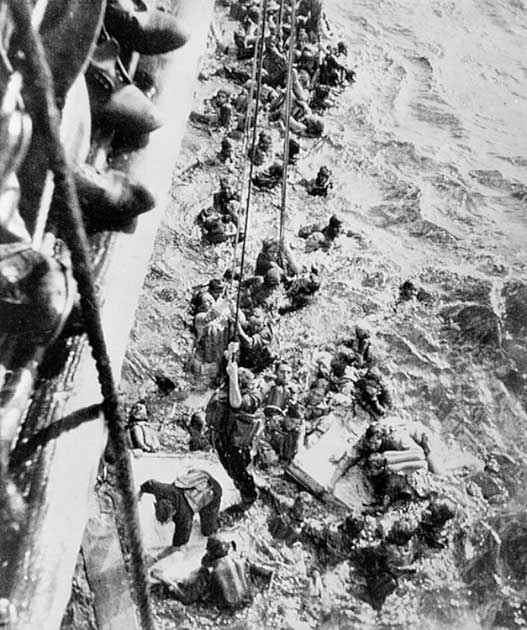Many of the initial successes Hitler enjoyed at the outset of World War II were down to timing. Nazi preparedness and the willingness to strike first and strike quickly through their innovative “Blitzkrieg” assault wrong-footed France and led to her fall within a year.
But it was the German preparedness that carried her forces in the early months of the war. They had the most experienced and combat ready soldiers, they had arguably the best fighter planes, and at sea, alongside their fearsome U-boats they had a brand new “pocket battleship” ready to take the fight to the Allied navies. This was the Bismarck.
The German battleship Bismarck was the leading warship of the German naval forces, and the pride of Hitler during World War II. The Bismarck was launched in February 1939, and every German naval captain hoped that the gigantic ship would bring many glories home.
Newer, more advanced and more dangerous than anything in the British navy, the Bismarck presented an immediate threat to British control of the seas and it seemed that Hitler was not planning on keeping her in port: she would take the fight to her enemies. The Admiralty in London was faced with a serious problem: she had to go, but how?
A Monstrous Threat
The Bismarck was a large, easily recognizable warship. She weighed around 50,000 tons (45,360 tonnes) when she was fully loaded with artillery and men. She was over 250m (820 feet) long and still holds the record, along with her sister ship, as the largest battleship ever built by Germany.
Only the much thinner and much older HMS Hood of the British Navy was longer than Bismarck, and when the latter put to sea in August 1940 she was the most dangerous thing afloat. Bristling with armament and the latest technology, she had larger guns, thicker armor and could run at 30 knots for days. Nothing in the Atlantic was safe.
The Ship was commissioned on 24 August 1940, and later in March 1941, it was entrusted with its first operation, Operation Rheinübung. Bismarck was to target the Atlantic routes on which merchant ships between Britain and North America sailed regularly.
These merchant ships would bring important supplies to Britain, which were crucial for a Britain to stay in the war. The Bismarck sailed from Gotenhafen on Poland’s northern coast with an escorting cruiser ship Prinz Eugen on 19 May 1941.
The Royal Navy of Britain was already under immense pressure from the German naval forces. Many British merchant ships were already sunk by German ships on the Atlantic routes. Britain was, therefore, determined to protect the ships from further German attack, even if that meant throwing everything at the formidable Bismarck. They had to sink her.
By 20 May 1941, British forces knew that the Bismarck was operational and at sea. The two ships were photographed for the first time by an RAF pilot near Bergen in Norway. Once Britain was sure that it was indeed the Bismarck, the Royal Navy sent cruiser ships to the Denmark Strait and the Faroe Gap: these were likely routes for the Bismarck to pass into the open ocean.
The patrolling fleet was formidable, led by the world-famous HMS Hood and the battlecruiser HMS Prince of Wales.
The Chase Between Hood and Bismarck
On 23 May 1941, the Bismarck and Prinz Eugen sailed through the Denmark Strait. The crew of Bismarck tried to move through the route without being detected by the Royal Navy. However, she was spotted and the Royal Navy cruisers HMS Suffolk and HMS Norfolk tailed the two German ships until the larger warships arrived.
Bismarck was shadowed by these smaller ships, careful to stay out of range of her guns. In this they were successful, and around 5:45am on 24 May 1941, five days after Bismarck had put to sea, HMS Hood and HMS Prince Of Wales closed in on the two German battleships. Eight minutes later the opposing forces engaged in a naval battle.

Bismarck shone in her first engagement, which was a catastrophe for the British. Within nine minutes of the battle, HMS Hood took a hit to her ammunition stores and exploded. She sank with only three survivors of the 1,415 men on board.
Prince of Wales had also sustained considerable damage to its structure, and was forced to withdraw to a safe distance. Bismarck had proven to be even more dangerous than the British Admiralty had thought.
However, the Royal Navy ships, conscious of their duty, continued to shadow the two German ships for the rest of the day. If the Royal Navy had given up chase that day, the Bismarck would most likely have escaped.
Bismarck had however taken damage in the engagement, being hit by shells from the Prince of Wales, and was leaking oil. Admiral Lütjens, the group captain aboard Bismarck and in overall command, was aware that the Royal Navy was mobilizing more warships to the Atlantic routes so that the Bismarck could be slowed down and sunk.
Bismarck dissuaded her pursues by turning to fire and than made a dash for the French port of Saint Nazaire. Lütjens knew that if he could get her there she could be repaired and sent straight out into the Atlantic. And she was still faster than anything the Royal Navy had.
To slow the Bismarck down, the Royal Navy launched an airstrike from the aircraft carrier HMS Victorious. The airstrike was launched some 100 miles away from Bismarck and, it was hoped, would give an advantage to British forces.
The Damaged Bismarck
While Bismarck was dodging the airstrike, she was struck by two British torpedoes. One hit the center of the ship, which further flooded and slowed the Bismarck: she could now be caught. However as the skies darkened the British were forced to abandon the chase to protect their fleet from U-boats, and Bismarck managed to escape and vanish into the night.
- Did Germany’s Amerika Bomber Ju 390 Secretly Fly to U.S.?
- Fireships in the Night: How was the Spanish Armada Defeated?
The second torpedo had hit Bismarck’s stern, causing mostly shock damage but also damaging her rudder. Unbeknownst to the British, Bismarck’s helm no longer answered, and she was trapped in a slow turn to port.
On the morning of 26 May 1941, the Royal Navy had lost track of Bismarck, and the searching ships were running out of fuel. However, at around 10:30am, the Royal Navy was informed that Bismarck had been found and was speeding east. Bismarck was only a day’s sailing away from safety when British warships found her again, battered and bruised.
Bismarck fought its last battle on 27 May 1941 at around 9am. The giant ship was afloat but trapped. The Royal Navy approached the ship with two battleships HMS King George V and HMS Rodney. The cruisers HMS Norfolk and HMS Dorsetshire also accompanied the warships.

The British ships fired around 3,000 shells and scored hits on the Bismarck for more than an hour. The Bismarck could not fight properly because she was unable to maneuver and bring her guns to bear.
In half an hour it was all over. Bismarck’s mighty guns were out of action and Rodney closed to point blank range to deliver the coup de grace. Two torpedoes launched by Rodney caused uncontrolled flooding and Bismarck was sunk.
The Bismarck had an original crew of 2,200 men, of which only 110 survivors were saved by the British warships. Lütjens died in battle, and Lindenmann, commander of the Bismarck, was seen sinking with the ship, standing on its deck, hand raised in a salute.
The sinking of Bismarck was quite tragic, and even those who sunk the ship considered it to be a terrible fate for such a magnificent beast of battle. The sinking of Bismarck undermined German naval forces and their abilities. Hitler restricted Germany’s naval efforts to a great extent after Bismarck went down on that fateful night, scared to chance his fleet at sea.
Oddly, there is no name for the final battle which sank Bismarck. Her wreck was not found until 1989, where she will remain forevermore.
Top Image: The formidable Bismarck puts to sea. Source: Bundesarchiv / CC BY-SA 3.0 de.
By Bipin Dimri